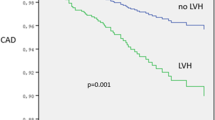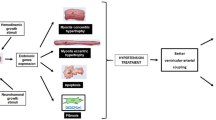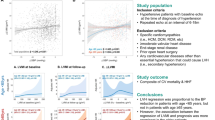Abstract
Background: Hypertensive patients with left ventricular hypertrophy (LVH) need a prompter and more intensive pharmacological treatment than subjects without evidence of cardiac involvement. So the detection of LVH plays an important role for decision-making in hypertensives.
Objective: To evaluate the impact of different echocardiographic criteria to define LVH in a more precise stratification of absolute cardiovascular risk in hypertensives without target organ damage (TOD) as assessed by routine investigations.
Methods: A total of 100 never treated patients with grade 1 and 2 essential hypertension (53 men, 47 women, age 44 ± 12 years) referred for the first time to our outpatient clinic were included in the study. They underwent the following procedures: (1) family and personal medical history, (2) clinic blood pressure (BP) measurement, (3) routine blood chemistry and urine analysis, (4) electrocardiogram, (5) echocardiogram. Risk was stratified according to the criteria suggested by the 1999 WHO-ISH guidelines. TOD was initially evaluated by routine procedures only, and subsequently reassessed by using six different echocardiographic criteria to recognise LVH: (a) left ventricular mass index (LVMI) >120 g/m2 in men and 100 g/m2 in women; (b) 125 g/m2 in men and 110 g/m2 in women; (c) 134 g/m2 in men and 110 g/m2 in women; (d) 125 g/m2 in men and 125 g/m2 in women; (e) 51 g/m2.7 in men and 47 g/m2.7 in women; (f) 126 g/m in men and 105 g/m in women.
Results: According to the first classification based on routine investigations, 46% were low risk and 54% were medium risk patients. Significant changes in risk stratification were obtained when LVH was assessed by echocardiography. A percentage of patients, ranging from 9 (f) to 25% (d), were found to having LVH according to different criteria, and consequently moved from low and medium risk strata to high risk stratum.
Conclusions: The detection of LVH by echocardiography allowed a much more accurate identification of high risk patients. In particular our results suggest that: (1) cardiovascular risk stratification only based on a simple routine work-up can often underestimate overall risk; (2) a better standardisation in defining LVH is needed, considering that the impact of cardiac hypertrophy on risk stratification is markedly dependent on the echocardiographic criteria used to diagnose it.
This is a preview of subscription content, access via your institution
Access options
Subscribe to this journal
Receive 12 digital issues and online access to articles
$119.00 per year
only $9.92 per issue
Buy this article
- Purchase on Springer Link
- Instant access to full article PDF
Prices may be subject to local taxes which are calculated during checkout
Similar content being viewed by others
References
Casale PN et alValue of echocardiographic measurement of left ventricular mass in predicting cardiovascular morbid events in hypertensive men Ann Intern Med 1986 105 173–178
Levy D et alPrognostic implications of echocardiographically determined left ventricular mass in the Framingham heart study N Engl J Med 1990 322 1561–1566
Koren MJ et alRelation of left ventricular mass and geometry to morbidity and mortality in uncomplicated essential hypertension Ann Intern Med 1991 114 345–352
Ghali JK et alThe prognostic role of left ventricular hypertrophy inpatients with or without coronary artery disease Ann Intern Med 1992 117 831–836
Liao Y et alPrediction of mortality risk by different methods of indexation for left ventricular mass J Am Coll Cardiol 1997 29 641–647
Liu JE, Devereux RB Clinical assessment of cardiac hypertrophy in left ventricular hypertrophy. Scheridan DJ (ed) Churchill Livingston: London 1998 pp 11–16
Kannel WB, Dannenberg AL, Levy D Population implications of electrocardiographic left ventricular hypertrophy Am J Cardiol 1987 60 85 I–93 I
Devereux RB et alElectrocardiographic detection of left ventricular hypertrophy using echocardiographic determination of left ventricular mass as the reference standard J Am Coll Cardiol 1984 3 82–87
The Sixth Report of the Joint National Committee on prevention, detection, evaluation and treatment of high blood pressure Arch Intern Med 1997 157 2413–2446
World Health Organization – International Society of Hypertension guidelines for the management of hypertension Guidelines Subcommittee J Hypertens 1999 17 151–183
de Simone G, Ganau A, Verdecchia P, Devereux RD Echocardiography in arterial hypertension: when, why and how? J Hypertens 1994 12 1126–1138
de Simone G Guidelines for arterial hypertension: the echocardiography controversy J Hypertens 1999 17 735–736
Abergel E, Chatellier G, Battaglia C, Menard J Can echocardiography identify mildly hypertensivepatients at high risk, left untreated based on current guidelines J Hypertens 1999 17 817–824
Lauer MS, Anderson KM, Larson MG, Levy D A new method for indexing left ventricular mass for differences in body size Am J Cardiol 1994 74 487–491
Daniels SR et alIndexing left ventricular mass to account for differences in body size in children and in adolescent without cardiovascular disease Am J Cardiol 1995 76 699–701
de Simone G et alRelation of obesity and gender to left ventricular hypertrophy in normotensive and hypertensive adults Hypertension 1994 23 600–606
de Simone G et alEffect of growth on variability of left ventricular mass: assessment of allometric signals in adults and children and their capacity to predict cardiovascular risk J Am Coll Cardiol 1995 25 1056–1062
Wachtell K et alImpact of different partition values on prevalence of left ventricular hypertrophy and concentric geometry in a large hypertensive population in the Life Study Hypertension 2000 35 6–12
Devereux RB et alEchocardiographic assessment of left ventricular hypertrophy: comparison to necropsy findings Am J Cardiol 1986 57 450–458
Devereux RB, Reichek W Echocardiographic determination of the left ventricular mass in man: anatomic validation of the method Circulation 1977 56 613–618
Cuspidi C et alLack of correlation between left ventricular mass and diameter of left coronary artery main trunk in hypertensivepatients Am J Hypertens 1999 12 1163–1168
Schillaci G et alImproved electrocardiographic diagnosis of left ventricular hypertrophy Am J Cardiol 1994 74 714–719
Agabiti-Rosei E et alon behalf of the RACE Study Group. ACE inhibitor Ramipril is more effective than the beta-blocker Atenolol in reducing left ventricular hypertrophy in hypertension. Results of the RACE (Ramipril cardioprotective evaluation) study J Hypertens 1995 13 1325–1332
Hammond IW,et alThe prevalence and correlation of echocardiographic left ventricular hypertrophy among employedpatients with uncomplicated hypertension J Am Coll Cardiol 1986 7 639–650
Zabalgoitia M Left ventricular mass and function in primary hypertension Am J Hypertens 1996 9 S55–S59
Ganau A et alPatterns of left ventricular hypertrophy and geometric remodelling in essential hypertension J Am Coll Cardiol 1992 19 1550–1558
Cuspidi C et alCardiovascular risk stratification in hypertensivepatients: impact of echocardiography and carotid ultrasonography J Hypertens 2001 19 375–380
Liebson PR et alEchocardiographic correlates of left ventricular structure among 844 mildly hypertensive men and women in the Treatment of Mild Hypertension Study (TOMHS) Circulation 1993 87 476–486
Coca A et alon behalf of the VITAE Investigators. The impact of different echocardiographic diagnostic criteria on the prevalence of left ventricular hypertrophy in essential hypertension. The VITAE study J Hypertens 1999 17 1471–1480
Abergel E et alWhich definition for echocardiographic left ventricular hypertrophy? Am J Cardiol 1995 75 488–502
Schillaci G et alContinuous relation between left ventricular mass and cardiovascular risk in essential hypertension Hypertension 2000 35 580–586
Ciulla MM et alVascular network changes in the retina during aging in normal subjects: a computerised quantitative analysis Ital Heart J 2000 1 233–236
Author information
Authors and Affiliations
Corresponding author
Rights and permissions
About this article
Cite this article
Cuspidi, C., Macca, G., Sampieri, L. et al. Influence of different echocardiographic criteria for detection of left ventricular hypertrophy on cardiovascular risk stratification in recently diagnosed essential hypertensives. J Hum Hypertens 15, 619–625 (2001). https://doi.org/10.1038/sj.jhh.1001242
Received:
Revised:
Accepted:
Published:
Issue Date:
DOI: https://doi.org/10.1038/sj.jhh.1001242
Keywords
This article is cited by
-
Echocardiographic partition values and prevalence of left ventricular hypertrophy in hypertensive Nigerians
BMC Medical Imaging (2006)
-
Change in cardiovascular risk profile by echocardiography in medium-risk elderly hypertensives
Journal of Human Hypertension (2003)
-
The hypertension-related organ damage: a poorly perceived danger in subjects with low education
Journal of Human Hypertension (2002)



